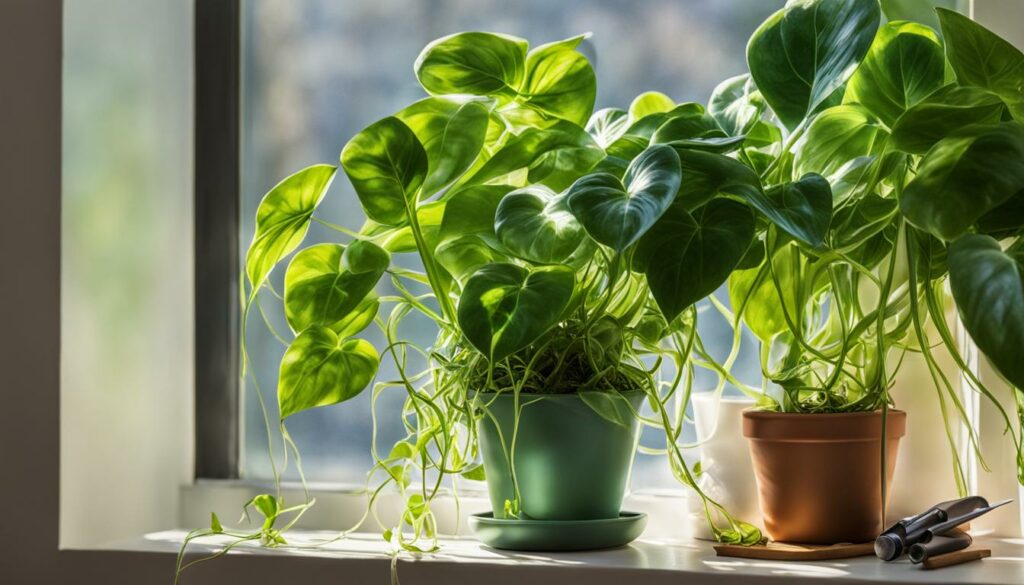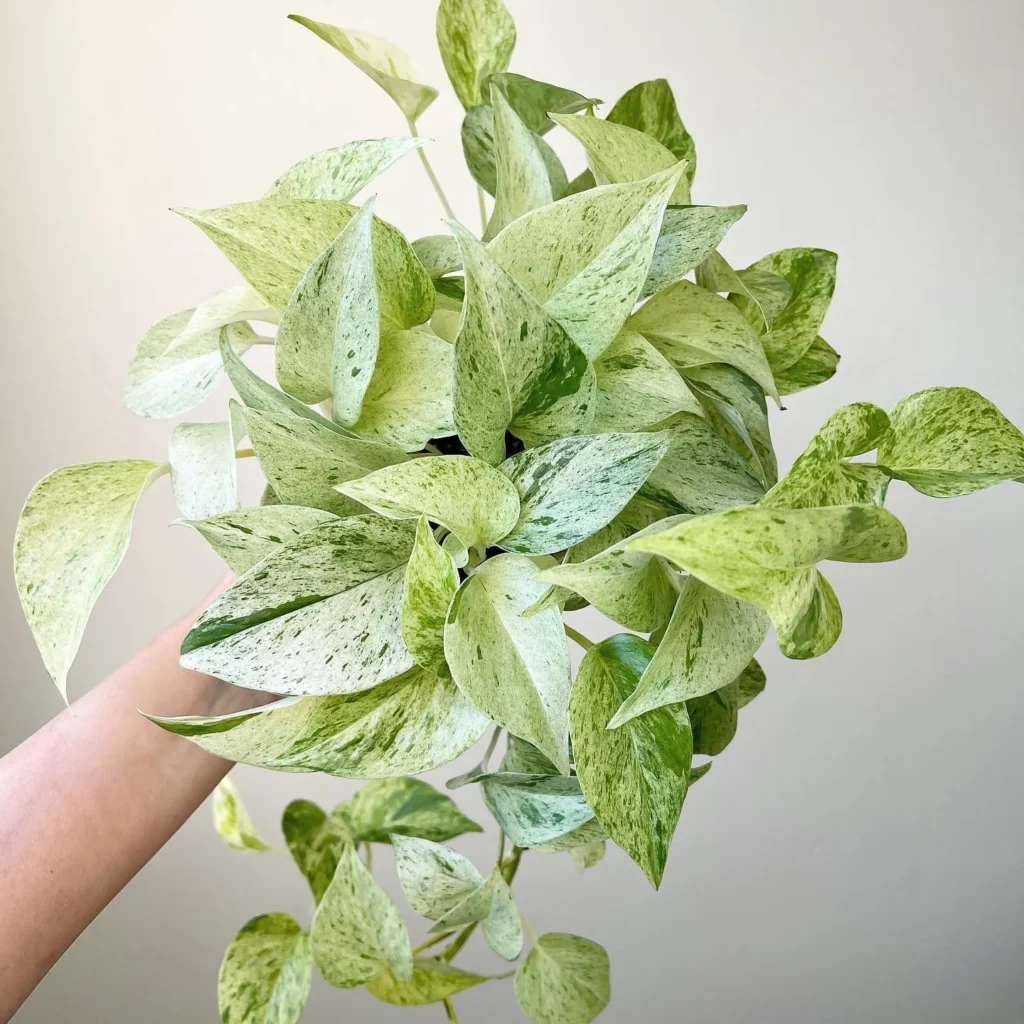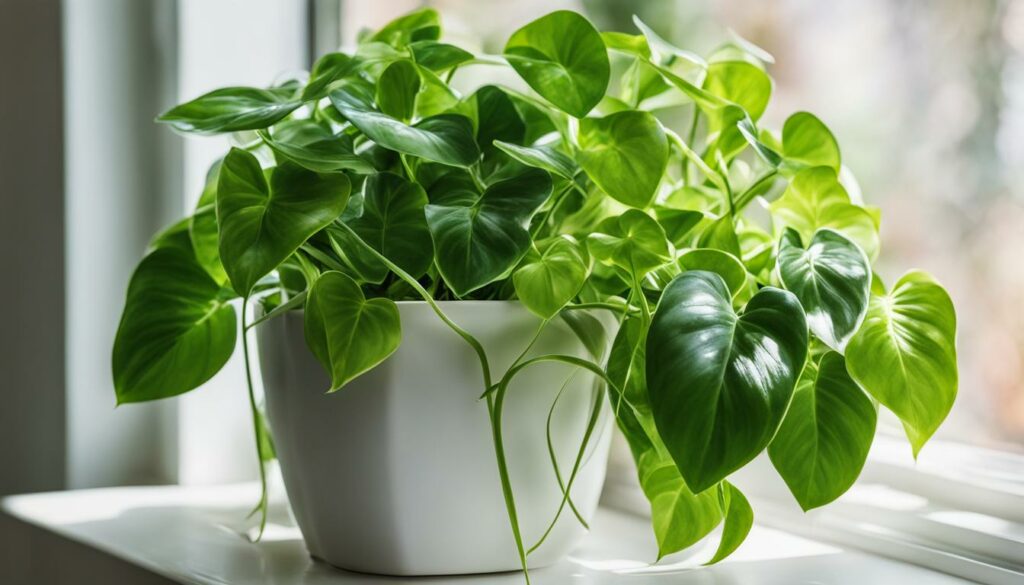This trailing plant, belonging to the Epipremnum aureum family, is known for its vibrant chartreuse heart-shaped leaves that can bring a pop of color to any space.
The Neon Pothos visually appealing and a low maintenance plant, making it perfect for those with busy lifestyles or beginners in plant care. And after reading this, check out our Complete Guide on Pothos (including photos and other varieties).
In this comprehensive care guide, I will provide you with tips on lighting, watering, soil, temperature, fertilizing, propagation, and common problems to ensure your Neon Pothos thrives.
About Neon Pothos: A Colorful Houseplant
Neon Pothos, also known as Epipremnum aureum “Neon,” is a vibrant and easy-to-care-for houseplant that adds a pop of color to any space. With its bright foliage and trailing vines, it is sure to catch the eye and bring life to your indoor environment. Neon Pothos belongs to the Epipremnum aureum family and is known for its stunning chartreuse-colored leaves.
One of the main reasons why Neon Pothos is so popular is its easy care requirements. It can thrive in a variety of lighting conditions, making it a versatile choice for different areas of your space.
Lighting and Temperature Requirements for Neon Pothos
When it comes to lighting, Neon Pothos thrives in bright, indirect light. This means placing it near a window where it can receive plenty of natural light, but avoiding direct sunlight.
Direct sunlight can cause the leaves to burn and damage the plant.
If you don’t have a well-lit area, don’t worry! Neon Pothos is also capable of tolerating low to medium light conditions, making it a versatile indoor plant that can adapt to different environments.
In terms of temperature, it’s important to provide the right conditions for Neon Pothos to thrive.
The ideal temperature range for this plant is between 55 to 90 degrees Fahrenheit (15 to 35 degrees Celsius).
It’s important to keep your Neon Pothos away from cold drafts and extreme temperature fluctuations, as these can negatively affect its growth and overall health. Maintaining a stable and comfortable temperature will help your Neon Pothos maintain its vibrant foliage.
Creating the perfect environment for your Neon Pothos
- Place your Neon Pothos near a well-lit window, but avoid direct sunlight
- Monitor the light levels and adjust the placement if necessary
- Maintain a stable temperature between 55 to 90 degrees Fahrenheit
- Avoid cold drafts and extreme temperature fluctuations
Watering and Soil Requirements for Neon Pothos
Proper watering and soil conditions are essential for the health and growth of your Neon Pothos. Here are some guidelines to help you keep your plant thriving:
Watering:
- Neon Pothos prefers evenly moist soil, but overwatering can lead to root rot. Allow the top 2-3 inches of soil to dry out between waterings.
- Water thoroughly when it’s time to water, ensuring that the water reaches the root zone. Avoid letting the plant sit in standing water, as it can cause the roots to suffocate.
- Remember that individual watering needs may vary depending on factors such as humidity, temperature, and pot size. Always check the soil moisture before watering again.
Soil:
- Use a well-draining soil mixture, such as a standard houseplant potting mix, to ensure proper drainage. This helps prevent waterlogging and allows the roots to breathe.
- Avoid using heavy soils that retain too much moisture, as this can lead to root rot. Look for a soil mix specifically formulated for indoor plants or create your own by combining equal parts of peat moss, perlite, and vermiculite.
- Consider adding organic matter, such as compost or coconut coir, to improve the soil’s moisture-holding capacity and provide essential nutrients to your Neon Pothos.
Fertilizing and Propagating Neon Pothos

When it comes to fertilizing Neon Pothos, less is more. This low maintenance plant does not require frequent fertilization, but applying a balanced liquid fertilizer once a month during the active growing season can help promote healthy growth. Be sure to dilute the fertilizer to half strength to prevent overfeeding.
When propagating Neon Pothos, stem cuttings are the way to go. Select a healthy stem with at least 4-5 nodes and make a clean cut just below a node.
Remove any leaves from the bottom nodes, as these will be submerged in water or soil. For water propagation, place the cutting in a glass of water, ensuring that the nodes are submerged. Roots will begin to develop in a few weeks.
For soil propagation, insert the cutting in a well-draining soil mixture, with the nodes buried. Keep the soil slightly moist and provide indirect light. Within a few weeks, roots will start to form.
Propagation Tips:
- Use a clean, sharp cutting tool to ensure a clean cut and minimize damage to the mother plant.
- Place the stem cuttings in water or soil immediately after taking them to prevent wilting.
- Provide a warm and humid environment to encourage root development.
- Avoid overwatering during propagation, as this can lead to rotting.
Troubleshooting Common Problems with Neon Pothos
Neon Pothos is generally a low-fuss plant, but it can face some common problems that may affect its overall health and appearance. Being aware of these issues and knowing how to troubleshoot them can help you keep your Neon Pothos thriving.
Overwatering or Underwatering:
- Yellowing or drooping leaves may be a sign of overwatering or underwatering. Check the moisture levels of the soil and adjust your watering accordingly.
Dry Air:
- Brown tips or edges on the leaves can indicate dry air. Increasing humidity levels around the plant or moving it to a more suitable location with higher humidity can help alleviate this issue.
Insufficient Light:
- If your Neon Pothos has small or pale leaves, it could be a sign that it is not receiving enough light. Consider moving the plant to a brighter location or providing supplemental grow lights to ensure it gets the light it needs.
Leggy or Bare Stems:
- Pruning your Neon Pothos regularly can help manage leggy or bare stems. By trimming back long stems and encouraging new growth, you can keep your plant bushy and full. Additionally, stem cuttings can be taken and propagated to create new plants.
FAQ
Q: How often should I water my Neon Pothos?
A: Allow the top 2-3 inches of soil to dry out between waterings and then water thoroughly.
Q: What kind of soil should I use for my Neon Pothos?
A: It is recommended to use well-draining soil, such as a standard houseplant potting mix.
Q: How often should I fertilize my Neon Pothos?
A: A balanced liquid fertilizer can be applied once a month during the active growing season.
Q: How do I propagate Neon Pothos?
A: Stem cuttings can be taken and rooted in water or a well-draining soil mixture. Cuttings should have at least 4-5 nodes and be placed in water or soil with the nodes submerged.
Q: Why are my Neon Pothos leaves drooping or turning yellow?
A: Drooping or yellow leaves may indicate either overwatering or underwatering. It is important to check the soil moisture levels.
Q: How do I prevent brown tips or edges on my Neon Pothos leaves?
A: Brown tips or edges can be a sign of dry air. Increasing humidity or moving the plant to a more suitable location can help.
Q: How do I encourage bushier growth in my Neon Pothos?
A: Pruning can encourage bushier growth. Trim back leggy stems and take stem cuttings for propagation.
Q: Can I grow Neon Pothos in direct sunlight?
A: Neon Pothos prefers bright, indirect light and should be kept away from direct sunlight, as it can cause the leaves to burn.




![Glacier Pothos 1 1024x585 1 | Bonsaimery.com Glacier Pothos Care Guide [Expert Guide] And Photos](https://bonsaimery.com/wp-content/uploads/2024/03/Glacier-Pothos-1-1024x585-1.jpg)

